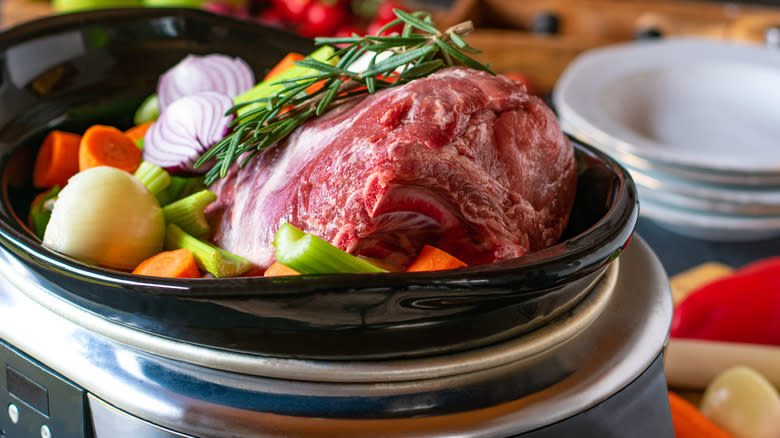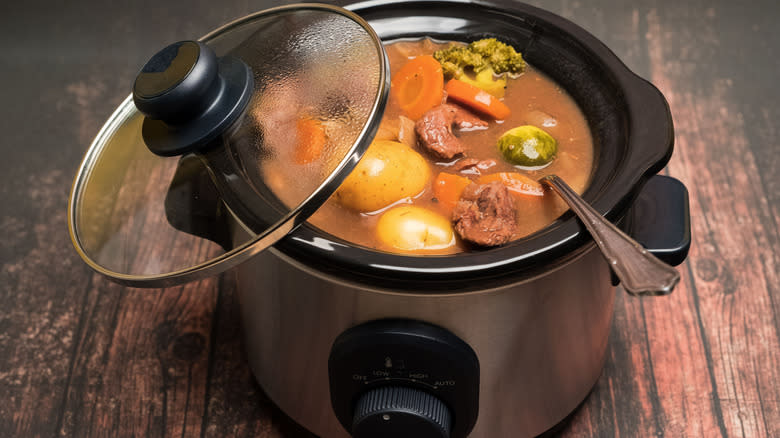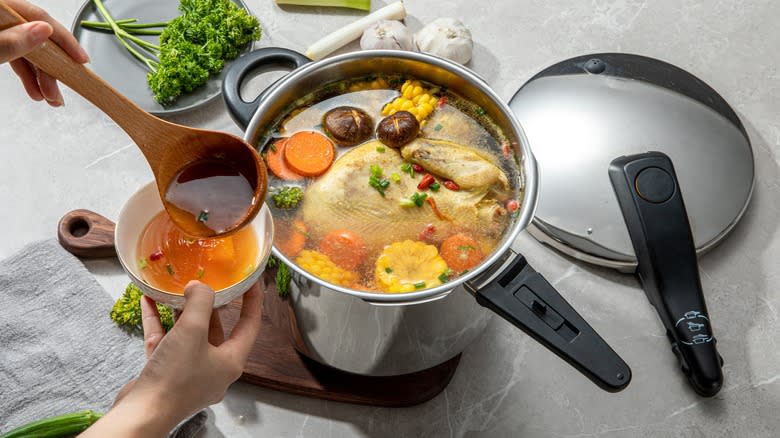What's The Difference Between A Slow Cooker Vs Pressure Cooker?

If you don't have much time to cook food at home, there are two tools you can use that will still provide a delicious meal: a slow cooker or a pressure cooker. Both can be left unattended (especially the electric kind), and both produce healthy, fully cooked, and delicious meals. The biggest difference between a slow cooker and a pressure cooker is the time each needs to do its job: Slow cookers, as you might imagine, cook your food at low temperatures over many hours, say, while you're away at work; pressure cookers use pressurized steam to cook foods in relatively short order.
So, much of your criteria about which cooker to use concerns how soon you need to eat. If you've got all day but won't be home, a slow cooker will safely braise your beef to perfection while you're away. Conversely, if you don't have hours to cook a chicken stew on the stovetop, a pressure cooker can do the job in a fraction of the time. Having said that, each device is better suited for some foods than others.
Read more: The Best Kitchen Gadgets You Can Buy
First Up: Slow Cookers

Let's start with the slow cooker. Its inventor, Irving Nachumsohn, learned about the Lithuanian Jewish tradition of cooking Sabbath stews called cholent made from meat, beans, and vegetables in the cooling ovens of local Vilnius bakeries. In 1940, Nachumsohn patented his own invention, an electric slow cooker that he called the Naxon Beanery -- later renamed the Crock Pot. He also invented the electric frying pan as well as an early lava lamp. But it's the slow cooker that is beloved to this day.
Slow cookers use a heating element to maintain a constant low temperature of around 190 degrees Fahrenheit. This makes them ideal for cooking things like beans, pot roasts, and Salisbury steaks without requiring either much electricity or culinary experience. (If you're new to this method of cooking, here's a bunch of amazing slow cooker recipes to get you started.) Because of how they work, slow cookers aren't really suited for lean cuts of meat (which they'll turn into jerky), seafood, rice and pasta, or soups and stews. Those jobs are for pressure cookers.
Now The Pressure Cooker

The pressure cooker has been around much longer than the slow cooker, having been invented in 1679 by French physicist Denis Papin. His Steam Digester not only increased the boiling temperature -- consequently reducing cooking time -- but also featured the world's first safety valve. As you might imagine, steam and high pressure are not the safest combination, and the history of pressure cooking is rife with injury, with various brands being pulled from the market.
Happily, modern electric pressure cookers are safe to use when appropriate common sense precautions are taken. They're great for everything from soups and pulled pork to short ribs and mac and cheese. Best of all, they'll cook your food faster than any other appliance in your kitchen -- except possibly the microwave. That said, would you ever make microwave beef stroganoff? Modern appliances such as instant pots -- also known as multi-cookers -- can handle both pressure and slow cooking, as well as many more culinary options, including yogurt making. Check out these easy instant pot dinner recipes to get started.
Read the original article on Daily Meal.

